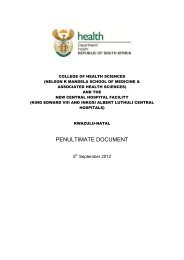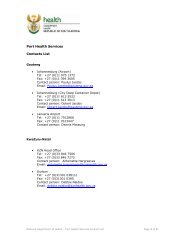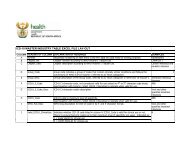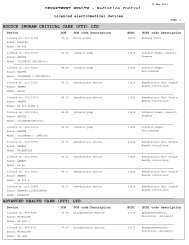National Norms and Standards relating to Environmental Health
National Norms and Standards relating to Environmental Health
National Norms and Standards relating to Environmental Health
Create successful ePaper yourself
Turn your PDF publications into a flip-book with our unique Google optimized e-Paper software.
Operational requirements for laundering in health facilitiesa) A policy for the management of linen in a facility should be in place;b) Adequate resources should be provided <strong>to</strong> ensure effective laundering of linen, including for propermaintenance of buildings <strong>and</strong> equipment;c) A quality management system should be established incorporating:• work instructions <strong>and</strong> procedures;• process control procedures;• quality control procedures; <strong>and</strong>• control of linen (clean/soiled) procedures.;d) A procedure specifically for infection/contamination control must be made available <strong>to</strong> staff h<strong>and</strong>linglinen. The procedure should include control measures through differentiation between categories ofsoiled linen, i.e. of high-risk <strong>to</strong> normal soiled linen:• Category A (red bag) = high risk infection for immediate incineration;• Category B (yellow bag) = sealed alginate bags of high-risk (blood/body fluids contaminated orsluiced) for direct loading in<strong>to</strong> washing machines;• Category C (yellow bag/hazard label) = sealed hazardous material (chemical, anti-neoplasticdrugs or radio-iso<strong>to</strong>pes) for direct loading in<strong>to</strong> washing machines.• Category D (white bag) = normal linen of no risk during h<strong>and</strong>ling;e) A clear policy on health <strong>and</strong> environmental protection must be documented <strong>and</strong> communicated <strong>to</strong> alllaundry staff;f) A person designated as the laundry controller should ensure that requirements regarding pollution,occupational <strong>and</strong> environmental hygiene are complied with, including appropriate action in respect ofany risks associated with infection or other hazards; <strong>and</strong>g) Procedures for the use of protective clothing <strong>and</strong> personal hygiene where staff are in contact withhigh-risk areas or linen must be documented <strong>to</strong> include precautionary measures.h) The laundry management/controller <strong>and</strong> other designated staff must be trained <strong>and</strong> be competent on:• carrying out their functions effectively;• h<strong>and</strong>ling hazardous goods in the laundry service;• following procedures (including first aid) with regard <strong>to</strong> prevention <strong>and</strong> control of infection;• using protective clothing <strong>and</strong> follow procedures for decontamination; <strong>and</strong>• operating laundry machines in order <strong>to</strong> ensure optimum results including general safetyprocedures;i) Laundry staff must be required <strong>to</strong> pass the appropriate medical examination at appointment followedby routine health moni<strong>to</strong>ring as prescribed by occupational health <strong>and</strong> safety legislation; <strong>and</strong>Keeping of records for health facility launderinga) The laundry management <strong>and</strong> quality system must ensure that appropriate records are kept of allactivities that affect linen <strong>and</strong> quality;b) The laundry data control system must include a master list of documents <strong>to</strong> facilitate the location <strong>and</strong>revision of records or documents;c) The results of inspections/checks <strong>and</strong> quality control tests should be documented <strong>and</strong> indicate theneed for remedial action where necessary;d) Accurate records of s<strong>to</strong>cks of chemicals, cleaning agents <strong>and</strong> detergents should be maintained;e) A full set of up-<strong>to</strong>-date materials safety data sheets for all washing or cleaning chemicals used in thelaundry must be available in one location <strong>to</strong> staff likely <strong>to</strong> become involved in the control of anemergency situation;f) Operation <strong>and</strong> maintenance records of plant <strong>and</strong> equipment, including records of special precautions<strong>to</strong> ensure minimum risk of cross-infection of laundered items should be kept; &g) Records of medical examinations, health moni<strong>to</strong>ring <strong>and</strong> training of staff should be kept.4. Infection prevention <strong>and</strong> controlb) Infection control <strong>and</strong> prevention st<strong>and</strong>ards concurrent with the st<strong>and</strong>ards as set out in the CoreSt<strong>and</strong>ards for <strong>Health</strong> Establishments in South Africa, published by the <strong>National</strong> Department of <strong>Health</strong>,Office of the <strong>Health</strong> St<strong>and</strong>ards Compliance.DOH. <strong>Norms</strong> <strong>and</strong> st<strong>and</strong>ards for environmental health in South Africa Feb 2013 52


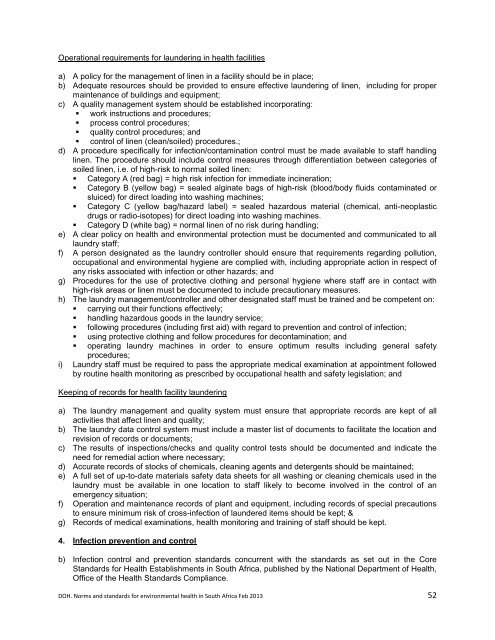
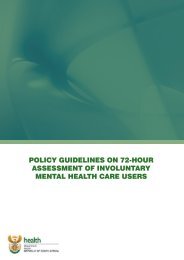
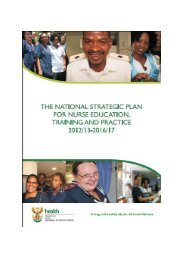
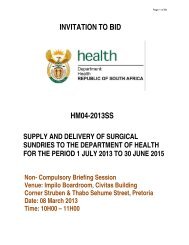
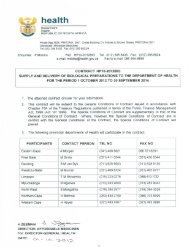
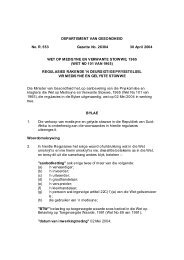
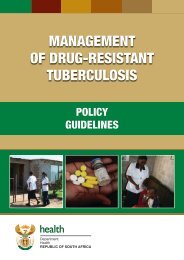
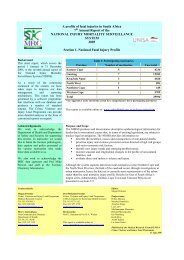
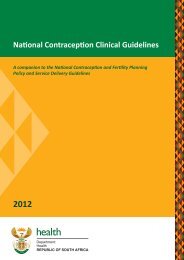
![A monograph of the management of postpartum haemorrhage [2011]](https://img.yumpu.com/15578784/1/184x260/a-monograph-of-the-management-of-postpartum-haemorrhage-2011.jpg?quality=85)
